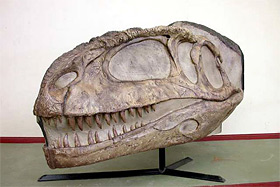 |
 |
 |
 News from Around the Americas | April 2006 News from Around the Americas | April 2006  
A Bigger, Badder Prehistoric Beast
 Jia-Rui Chong - LATimes Jia-Rui Chong - LATimes


| | A reconstructed skull of a meat-eating dinosaur, with blade-like teeth, dubbed Mapusaurus roseae. (Rodolfo Coria/AP) |
The fossilized remains of what may be the largest meat-eating dinosaur has been discovered in Argentina — a bus-sized monster that attacked its prey in roving packs, scientists announced Monday.

The remains of at least seven of the beasts, named Mapusaurus roseae, were found clustered in 100-million-year-old rocks south of the city of Plaza Huincul in western Patagonia.

Based on a shin bone that was about 3 feet long, researchers estimate that the largest adult in the group stretched about 41 feet and weighed about 15,000 pounds.

"When I was growing up, Tyrannosaurus rex was the big, nasty meat-eater on [the] block, but here we've got other things vying for the king of nasty," said Tom Demere, curator of paleontology at the San Diego Natural History Museum, who was not involved in the discovery. "This thing here kind of fits that bill."

The new dinosaur ran on its hind legs like Tyrannosaurus rex, but had teeth that suggested a different way of killing its prey.

The thin, blade-like teeth of Mapusaurus probably sliced the flesh of other dinosaurs, in contrast to Tyrannosaurus rex's stronger, spike-shaped teeth that crunched through its prey.

Rodolfo Coria, a paleontologist at the Museo Carmen Funes in Plaza Huincul and lead author of the study, said the cluster of Mapusaurus fossils suggested that the dinosaurs were part of a single group that possibly coordinated attacks on their natural prey, the 125-foot long Argentinosaurus, the largest dinosaur ever discovered.

"The theory was that large meat-eating dinosaurs were lonely hunters," Coria said. "With Mapusaurus, we would not say all of them are. Maybe some of them hunt in packs."

He said he wasn't sure why the Mapusaurus fossils were all found together.

"We didn't find any evidence of disease, any accident or catastrophic death," he said. "So maybe they just drowned when they were going across a river or died of starvation."

The new dinosaur was named after the word "Earth" in the language of the local Mapuche tribe. Its species name was taken from the project's principal funder, Rose Letwin.

The finds in Patagonia have helped fill some holes in what scientists know about the geographic distribution of dinosaurs.

"Up until a few years ago, dinosaurs from the southern hemisphere were almost nonexistent," Demere said. "Now, with this work here and in Africa and Madagascar, we get a better sense of the dinosaur diversity."

Paleontologists said Patagonia competes with Liaoning province in China as one of the richest fossil beds in the world.

The fossils were discovered in the same area where scientists had discovered Giganotosaurus, which previously held the size record for meat-eating dinosaurs.

Mapusaurus had a longer, thinner shin bone than its cousin Giganotosaurus, leading researchers to suspect that the new dinosaur may have been longer, but perhaps not as husky.

Jack Horner, curator of paleontology at the Museum of the Rockies in Bozeman, Mont., cheered the find, but cautioned that much more research is needed to determine if the beasts hunted in packs.

"The fact that a number of them were found together certainly indicates that they probably were social, but I think that's as far as you can go," said Horner, who was not involved in the excavations.

He was also skeptical that Mapusaurus would remain the king of the meat-eaters for long.

"Kids will love it, but it's not unexpected," he said "I guarantee in the next few years we'll find another bigger than that." | 
 | |
 |



